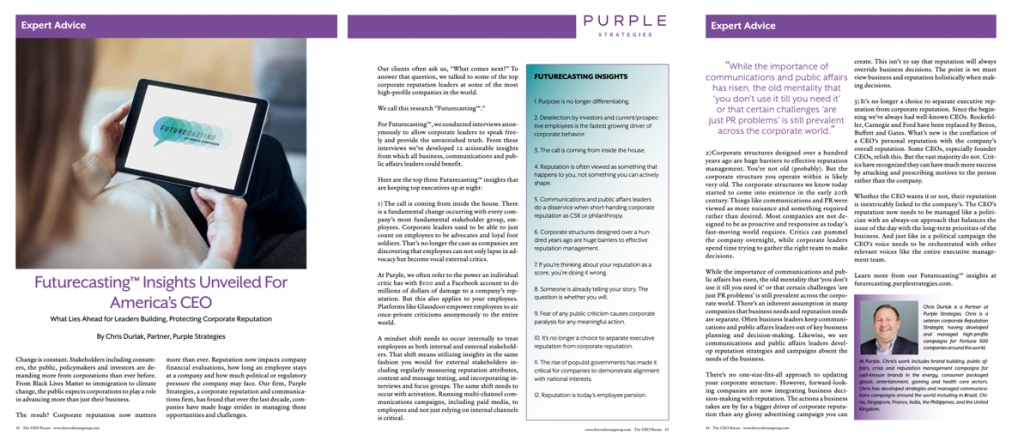Uncategorized

Posted on
April 13, 2021
7 Min. Read
Author
Purple Strategies
CEOs Pivot from Health Crisis to Human Connection
5 Themes from The CEO Forum’s First Transformative CEO Summit
Purple Strategies is the thought leadership and polling partner of The CEO Forum Group and Transformative CEO Summit. The CEO Forum convened its inaugural Transformative CEO Summit on February 25, 2021, featuring more than 50 CEOs of leading companies discussing creative ways to solve today’s most pressing challenges. This article first appeared in the digital magazine of the inaugural Summit.
When the CEOs of more than 50 leading companies gathered for the first-ever Transformative CEO Summit to suggest and debate creative approaches to addressing today’s most pressing challenges, the anniversary of the start of the COVID era was near.
And while the pandemic didn’t have a slot on the Summit agenda, its lessons and legacy wove through the keynotes and discussions as a strong and distinctive thread: The importance and resurgence of human connection emerged from transformative CEOs as the unifying lens through which these leaders reflect on the unprecedented events of the past year and look ahead with optimism and renewed purpose.
In a year when “success” required the world to avoid close physical contact and to shift to a digital-first posture, our shared experience characterized by the lack of human connection crystallized for CEOs the myriad ways human connection can be differentiating for a company as we enter this next era. Whether discussing technology, finance, corporate citizenship or any other topic, the CEOs repeatedly surfaced an array of elements of human connection as being critical to advancing the goals of their organizations and meeting their obligations to society – as individuals and as corporations.
The following forces related to connection are ones transformative CEOs recognize as shaping the business landscape at this moment.
(1) A new era of empathy.
Business leaders across industries recognized that COVID has ushered in a new era of empathy, in which business itself must play a central role in prioritizing the physical and emotional wellbeing of all stakeholders – employees, customers, partners, suppliers, and the communities in which they operate. As companies look to re-open and in some cases reinvent their industries, leaders will be particularly attuned to the safety and security of their employees, for whom continued corporate empathy will be integral to their business success and driving toward strong reputation outcomes, including trust and talent recruitment/retention.
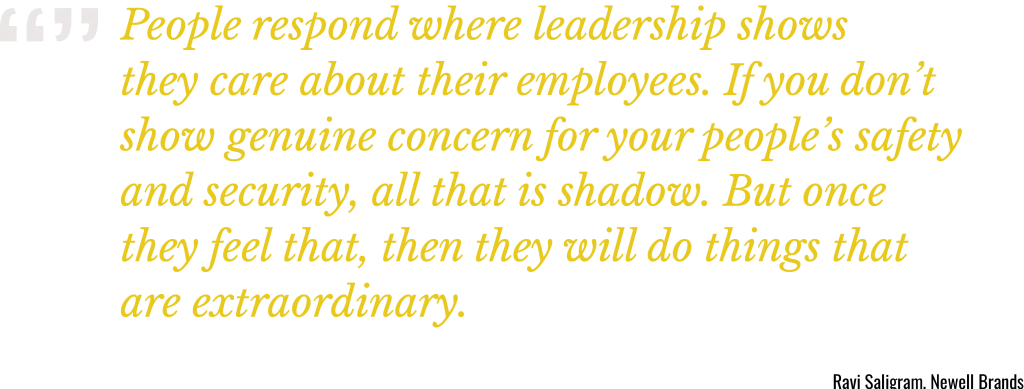
(2) The promise of a deeper, more human embrace of tech.
COVID significantly impacted businesses’ reliance on technology, as many were forced to adopt or accelerate their adoption of digital solutions in order to compete, or even simply survive. Recognizing that rapid technological change is never without disruptions, industry is now looking to the convergence of the physical and digital world – the “phygital” space – to combine technology with human intellect and drive competitive advantage and continued business transformation.
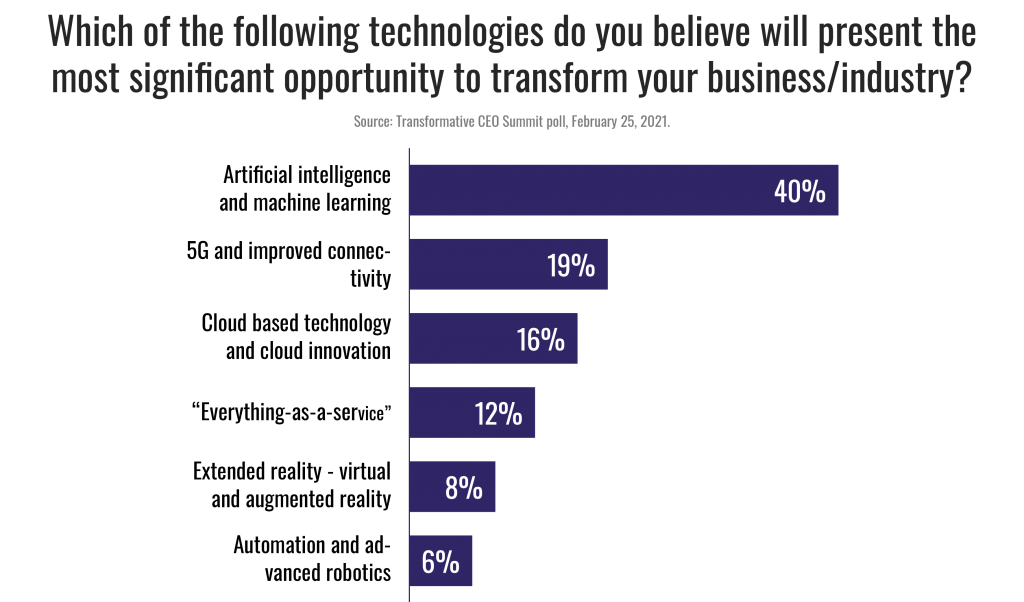
(3) An inflection point for Purpose.
While corporate America has signaled its intention to move beyond shareholder primacy and instead serve a broader mix of stakeholders, COVID accelerated the need for businesses to translate Purpose into action. Companies that responded to the moment adopted flexible work-from-home policies, found ways to support single parents and those struggling with childcare, offered discounts and deals to offset the financial strain many were feeling, and prioritized employee health and safety. As they move beyond this moment, leaders stressed the importance of continuing their commitment to serving a full coalition of stakeholders and defining their Purpose through action.

(4) Urgent acceleration of focus on diversity, equity and inclusion.
The recent and overdue reckonings around racial justice and gender inequality forced companies to look in the mirror and across the boardroom to evaluate whether their stated corporate values matched their business realities. The lack of diversity among the CEO population itself is an important reminder of the significant gap between the two. Transformative leaders are resolved that the private sector must shift away from talking points in favor of tangible action to address inequalities across industry sectors (and particularly in finance, healthcare, education and tech); bring about greater representation and diversity in the executive ranks and boardrooms; and charge every employee in moving companies in a positive direction.
(5) A new and enduring legacy of crisis preparedness.
The ongoing global pandemic delivered a wake-up call to corporate leaders that this type of event can and will come again, and the organizations that will survive in the long-term are those that are already preparing for the next crisis event. While society more generally might yearn for a “return to normal” there is little room among executives for nostalgia to go back to the way things were before. Transformative leaders are approaching decision-making and forecasting with the lens of when not if. Proactively preparing for the inevitable next global catastrophe will demand that companies assume a culture of innovation and a willingness to adapt that will be key to their survival.

Leaders at the Transformative CEO Summit helmed their companies through an unprecedented crisis that upended the business world (not to mention every facet of society), and convinced them of the certainty of crises to come. Despite this, many of these leaders expressed a sense of optimism – optimism in their ability to reinvent their industries and play a role in rebooting society in the wake of massive disruption, and optimism in their ability to confront and navigate future challenges. For proof and inspiration, leaders pointed to previously unseen cross-industry collaboration, technological adoption, agility in decision-making, and building a culture of “yes” – in some cases overnight – to adapt to this disruption.
They revisited their values; prioritized corporate citizenship, diversity, and inclusion; and challenged themselves to manifest Purpose through action, for all of their stakeholders. CEOs hope to enshrine the lessons learned over the last year, along with greater appreciation of human connection, through their leadership well beyond COVID.
Purple Strategies is the thought leadership and polling partner of The CEO Forum Group and Transformative CEO Summit. Purple formed 12 years ago when two political firms that were asked regularly to partner together to bring a mix of “Red” and “Blue” perspectives to corporate challenges decided to join forces. Through the years Purple has continued to evolve, bringing in diverse perspectives across a multitude of disciplines. Today, Purple is an independent, fully integrated corporate reputation strategy firm, inspired by politics, driven by data and insights, partnering with clients around the world to anticipate, navigate, and compel change. Purple blends the creativity of brand communications and the speed and strategy of political campaigns to serve Fortune 500 companies, coalitions, associations, non-profits, and some of the most recognizable brands in the world.

Posted on
March 25, 2021
4 Min. Read
Author
Lindsay Christel
Managing Corporate Reputation on TikTok
While it may feel as if TikTok appeared overnight at the beginning of the pandemic, the video-first app has been rapidly growing since its release in 2016. In the United States alone, the app has seen an astounding 800% increase in monthly-active users from January 2018 to August 2020.
As more and more users flock to TikTok, brands are beginning to find success in marketing through the platform. But when it comes to driving and protecting brand reputation, teams are scrambling to navigate the TikTok rules of engagement.
There are certainly positive and productive ways to insert your brand into a viral TikTok challenge or use the platform to drive brand reputation, but what happens when your company becomes the face of negative backlash spreading like wildfire and reaching millions? Many teams are caught flatfooted with little knowledge of the app’s capabilities and no plan of action to put out the fire. But that doesn’t have to be your brand’s story.
We’ve unpacked three important takeaways for brands to consider when scenario planning and responding to reputation issues related to TikTok.
(1) Issue lifespans are unpredictable because time is meaningless on TikTok.
While time is a major factor for algorithms on Facebook, Instagram, and Twitter, TikTok algorithms are mostly based on user interaction and preference. Therefore, users dictate the lifespan of an issue and it only dissipates when its relevancy among users drops.
In addition, videos on TikTok don’t show timestamps, which means that even videos that are months-old can be served to users and suddenly go viral without warning. Research from the University of Illinois at Urbana Champaign indicates that social media users treat older content on social media differently, with anything more than two days old being less likely to generate engagement. TikTok’s veiling of original posting date shifts the rules of engagement, allowing something that would have been a fleeting trend on another platform to sustain and build through longer engagement periods on TikTok.
The sheer volume of content on TikTok creates new trends every hour of every day, so potential issues could also go as quickly as they came. It’s all up to the users.
Consideration for reputation leaders
- To get ahead of potential issues, include TikTok as part of your communications scenario planning and monitoring protocol. Because existing tools are unable to monitor and share alerts for topics on TikTok, it’s critical to regularly explore the app for potential issues. Evaluate now if your brand should create a TikTok account for response and engagement before an issue arises, so you’re better equipped to act swiftly.
(2) Misinformation is rampant, but community checks and balances exist.
Content on TikTok ranges from celebrity gossip to health to politics to sports and everything in between; videos can be silly and playful or serious and impactful. But similar to its peer apps, one thing TikTok is not immune from is mis- and disinformation. And while there are minimal formal guardrails to prevent the spread of falsehoods, defenders of science and truth can often be found in the comments section.
Scientific vigilantes take information they hear or see and conduct their own research to confirm or refute the content. For example, when product ingredients are under fire, they scour the web for legitimate sources and share what they’ve learned in the comments section, sometimes coming to the defense of specific brands, but more often fighting for the sake of valid science. Healthcare professionals are especially vocal in combatting falsehoods and sharing their knowledge. Those credible scientific voices can go a long way to change the narrative and have the potential to be invaluable assets to brands if the situation warrants.
Similar to other platforms attempting to combat misinformation, TikTok has recently added a warning when users click to share “unverified” content. Users will still be able to share the video, but the platform is hoping to encourage an extra pause for consideration before sharing.
Consideration for reputation leaders
- Identify credible voices on the platform who can speak on your behalf and set them up for success (i.e., through offering trainings or providing messaging materials). In addition, make sure your counter-narrative is discoverable for those conducting their own off-platform research.
(3) What happens on TikTok, doesn’t usually stay on TikTok.
There is power in TikTok’s community, and that power spreads easily. It has been harnessed to spread public health information, raise money for good causes, or even “sell out” a Trump rally. In our increasingly digital world, the content that’s shared on TikTok quickly finds its way onto Instagram, Twitter, headlines and even the nightly news. Keep in mind that as the platform changes, so does the audience.
It may be tempting to disregard TikTok because it’s “just for kids” or only produces “silly viral trends,” but that mindset could be potentially detrimental for your brand or product. Not only is the power of the TikTok community stronger and more diverse than many people think, but its tendency to jump off-platform alone is reason alone to prioritize it in your company’s reputation management planning.
Consideration for reputation leaders
- As TikTok issues arise, your action plan should reflect on- and off-platform responses. Consider what your audiences might come across in their Google searches. Will they be met by ads from trial attorneys and critical organizations, or will they be met with useful and authentic content from your website? Create a holding statement and prepare a spokesperson for instances when the issue spreads to news headlines and evening broadcasts. Prioritize an always-on approach through programmatic with critical segments. Take these TikTok issues seriously and prepare accordingly.
Purple partners with Fortune 500 companies, associations and coalitions to anticipate, navigate, and compel change. Please reach out to author Lindsay Christel or any member of our Purple team to let us know how we can support you.

Posted on
March 19, 2021
5 Min. Read
Author
Purple Strategies
5 Minutes With The Women Leading Purple
We grabbed five minutes with four executives leading critical segments of the business and people at Purple: the heads of our world-class creative and insights teams (Jillayne Rogers and Denise Brien), our executive and logistics function (Zibby Logie), and the firm as a whole (Kristen Morgante). And we asked them to share perspectives and thinking in honor of Women’s History Month. Here they reflect on the women who’ve inspired them, the best or worst leadership advice they’ve received, actions they think organizations could take to enhance their pipeline of women leaders, and more.
More on Kristen
More on Jillayne
More on Denise
More on Zibby

Posted on
February 24, 2021
10 Min. Read
Author
Purple Strategies
10 Challenges That Will Shape Year Two of COVID for Business Leaders
As we enter the second year of the COVID pandemic, Purple gathered a group of corporate reputation strategists who have spent the last year helping companies navigate some of the most important and central issues of COVID to identify key challenges that corporate leaders will likely face.
***
Purple is actively partnering with companies and industries to navigate the ever-changing COVID-19 pandemic and prepare for the future that will come after, bringing deep experience helping the world’s best-known companies navigate the world’s toughest challenges. Please reach out to any member of our Purple team to let us know how we can support you.
***
The intersection of the ongoing economic crisis, the continuing pandemic, the social justice movement and increasing inequality are just the short list of what leaders need to acknowledge, manage and help to solve.
Signing well-intentioned letters and making future commitments are sometimes appropriate but will not suffice at this moment. What is needed now are brave and courageous corporate leadership actions that can “bend the K-curve” economic recovery. Creation and adoption of employee policies and culture that accommodate varying degrees of fear, uncertainty, and unique personal circumstances will be essential. Leaders will need to imagine forward rather than look to playbooks of the past.
While companies will continue to deal with the pandemic head-on, we believe they will also increasingly have to navigate COVID in the background through two macro trends: (1) redefining “normal” as we return to normal, and (2) an acceleration of deepening societal divides in need of uniters. As seen through those lenses, here are 10 COVID challenges on the horizon for corporate boards and executive teams.
TREND 1: Return to “Normal”
The very notion of “normal” is now an unknown and shifting target. Corporate leaders must account for a multitude of ofttimes competing expectations from a complex web of stakeholders – employees, customers, communities, government, NGOs, climate activists, social champions – who all see business as critical to shaping a normalcy that works for many. Absent a shared understanding of “normal” or agreed-upon timetable for when that transition should occur, company leaders can expect to both drive and defend their decisions around the parameters of the new normal.
(1) As companies look to “build back better,” the question will be “better” for whom?
“Build back better” represents the Biden team’s economic recovery plan for American workers, pledging to “create millions of good-paying jobs” and to “treat American workers and working families as essential at all times, not just times of crisis.” But the hope for the American economy to be rebuilt in a more equitable way will be met with the reality that the radical changes in how companies worked during the pandemic will continue well past the pandemic’s end.
- Pandemic-necessitated automation is here to stay: The pandemic accelerated an already fast-moving trend away from high-touch jobs toward touchless alternatives – self-checkouts instead of cashiers, chatbots instead of call centers, automated toll tags instead of toll booth attendants, to name just a few. Companies that turned to technology to replace lost productivity during the pandemic are not likely to return to pre-COVID staffing levels, and additional job losses are likely as tech and automation solutions that went into development in the earliest shutdown come online in the days ahead.
- Desire for convenience will prevent return to pre-COVID consumer behaviors: American consumers have also benefited from convenience brought about by necessity – for example, the shift to e-commerce, which the pandemic accelerated by five years according to some estimates. Many consumers who initially adopted new habits during the pandemic to #flattenthecurve will give up their previous behaviors for good. But companies adapting to meet consumers’ shifting expectations and maintain efficiency gains will face reputational risk as a range of stakeholders question decisions that have directly or indirectly resulted in thousands of job losses.
- Transitioning workers will need a new champion: The pandemic has brought about the decline of jobs and industries faster than the impacted workforces can transition, and one of the primary safety nets in previous cycles – public funding of education – is itself a casualty of this pandemic. American businesses have an opportunity to fill this void.
(2) A permanent shift to work-from-home risks setting conditions for decreasing employee loyalty and increasing employee activism.
Many U.S. office workers who found themselves abruptly working from home in the interest of public health have now internalized work location flexibility as an expected benefit in corporate America’s “return to normal.” Companies wishing to retain and attract top talent will have no choice but to codify some level of workplace flexibility, and this shift away from central work locations will have several other potential repercussions.
- Work from home means anyone can work anywhere: Before the shift to remote work, some employees may have chosen to stay with their employer at least in part due to geography. While not the same as having a strong emotional connection to one’s employer, location nonetheless served as a reliable factor in talent retention. Greater work location flexibility will be an enduring effect of the pandemic. Employees will not easily part with what they clearly see as a benefit, and that same flexibility removes the geography-related obstacles to staying with one company.
- Decreasing connection to employers and co-workers: Workplace connections are another factor that fuel company satisfaction and loyalty, and COVID has disrupted the types of personal bonds between co-workers that form through social interactions outside of work. And employees hired during the COVID era have had few if any opportunities to form deep interpersonal relationships and connections with their co-workers at all.
- Company loyalty as a buffer against activism: As workplace personal relationships suffer, so too will company loyalty. Diminishing company loyalty (to the company or its people), in turn, lessens the hesitation some employees might normally feel going public with company issues, or conceals alternative (and more productive) internal avenues employees might have taken in the past to resolve issues and grievances.
(3) The CSR issue landscape will likely narrow but increase in importance in a depression-type era and climate emergency.
In a strong economy, thriving companies can look beyond the basics of their own financial health and security, and individual stakeholders have more leverage to demand companies deliver value beyond the bottom line. But the economic downturn prompted by COVID-19 has pushed many companies into survival mode – focused on business continuity and how to weather a storm of uncertain duration. As the pandemic economy continues, companies will not entirely abandon their CSR efforts, but some initiatives will be temporarily tabled, while others will become increasingly urgent.
- Divide over what to do, when: Partisan differences over which CSR initiatives to pursue and on what timeline won’t just play out in the political arena. They will also shape expectations and pressures on companies from external stakeholders and among their own employees. Conservative-leaning constituencies will push companies to focus on rebuilding the economy while liberal-leaning stakeholders will warn against delaying progress on priorities like social justice and climate change.
- Shared economic realities create attractive common ground: COVID’s economic impact has ignored party lines, making it an issue around which there’s a greater shared reality than many others in this pandemic. Providing economic relief will be a CSR territory on which corporate and political leaders from both sides of the aisle can cooperate.
- Convergence of business and social needs: Rather than forcing the selection of one or the other, companies and policy stakeholders will push for uniting economic and social needs. Action on a priority like infrastructure, for example, will also require making progress on the environment.
(4) The return to work and play will be both quicker and slower than Americans would like. Divergent expectations and lack of societal norms will create significant conflict that businesses will be forced to mediate.
From live events, to happy hours, to handshakes and hugs in social settings, being able to enjoy one another’s company in person again is one of the milestones most coveted by the public. Unfortunately, there will be no magic moment at which that milestone is achieved. Americans will have vastly different perspectives on when specific activities will be safe again, and under what circumstances, and businesses will be among the leading navigators of plotting the course back together.
- Vaccine policies and customer behavior intersect in the real world: Questions and concerns related to the COVID vaccine will move from the realm of public health officials and scientists to the realm of workers on the front line of businesses – the front desk worker in an office, the host or hostess in a restaurant, the greeter in a retail store, and the parking lot attendant at a concert venue, will need to become part of a company’s plans for enforcing the company’s vaccine policy with customers.
- Companies in a difficult position of mediating safety: Once government-directed safety protocols like mask mandates and capacity limitations start to ease, members of the public may still prefer that they continue for comfort and safety reasons. Companies will be in a position to set and enforce their own, custom network of regulations.
- Businesses will have to navigate the space between passionate camps: Compromise and diplomacy are often considered positive approaches to resolving differences, but they will prove to be ineffective in the face of the passions surrounding re-openings. Being in the middle of the “fast” and “slow” is a reputationally violent place to be and will present short- and long-term challenges for companies.
(5) Companies – and managers – will need to face America’s deteriorating mental health as it continues to directly impact the workplace.
News of COVID-19’s monumental impact on mental health is already well-documented. The effects of long-term isolation, reduced access to mental health services, the stress of managing the demands of work and home life, and the economic challenges people have faced, are just a few of many challenges COVID will leave in its wake. The pandemic’s mental health toll will continue having real implications for how businesses operate with employees and other stakeholders.
- Mental health as employer priority: In the near term, employers will be expected to continue investing time and resources into employees’ mental health in the form of mental health care coverage as well as policies like flexible hours, more direct engagement from managers, and health and wellness stipends.
- New spotlight on opioids: Companies already involved in defending against allegations of their role in the opioid crisis will face renewed attention and scrutiny for increases in addiction and dependencies resulting from the COVID era.
- Long-term impact on talent pipeline: While parents and schools are struggling with the learning and achievement gap now, employers will eventually be required to navigate the long-term effects of the “Quarantine Generation” or “Zoomers” – whose experience will have a lasting impact on their values, outlooks, and skillset.
TREND 2: The Acceleration of Deepening Divides, a Coming Reckoning, and the Need for Uniters
Deepening socio-economic divides have been exacerbated by a K-shaped recovery and the emergence of new segments of haves and have nots – who gets COVID, who gets the vaccine, who keeps their jobs. Companies will be forced to examine their own role in creating these divides while people will look to the private sector to bring about a sustained economic and societal recovery.
(6) The collapse of Main Street and small businesses will accelerate corporate reckoning over growing wealth inequality.
While the stock market has rebounded from early pandemic losses and many large corporations have reaped record profits, millions of American workers remain unemployed and more than 100,000 small businesses have permanently shuttered. With their commitment to the well-publicized Business Roundtable pledge serving as backdrop to the pandemic’s uneven devastation, companies will be held to account for their part in building an economy that does not serve all Americans.
- Reckoning and reform mindset: Calls for corporate accountability will grow and become a social and political norm. And with Democrats in full control of the federal government, corporations will see legislation that seeks to dramatically increase broad regulation, corporate accountability, and a rebalance of profits.
- Implications of a K-shaped recovery: As areas of the economy recover at different rates, the K-shaped recovery will have implications for how companies market to a divided customer base of haves and have nots. This will require a carefully calibrated strategy for targeting messaging at those fortunate enough to be on the upside of the K while so many remain in financial hardship.
- The end of “wealth worship” foreshadows broader shift in attitudes: American pop culture’s celebration of extreme wealth has seen a sharp pendulum swing as economic devastation has unequally impacted Americans. Celebrities and influencers who once racked up “likes” for ostentatious displays of wealth are now met with a flood of calls to “read the room.” This cultural shift will be felt across society and business.
(7) Social justice issues will stay front and center. Companies will face pressure to deliver beyond commitments made in 2020.
The disproportionate damage done to Black and Hispanic communities by COVID-19 will continue to surface systemic inequality in our society. In addition to broader social justice issues, three areas will emerge with COVID as the backdrop.
- Vaccine mandates reignite social justice tension and issues: Decades of mistreatment by the healthcare system has led Black Americans to pervasive mistrust of the healthcare industry, resulting in increased COVID vaccine hesitancy and significantly higher resistance to mandatory vaccination. A Purple survey in July 2020 found 51% of Black Americans would rather quit or be fired from their job than be required by their employer to take the vaccine. Vaccination policies for employees and customers may therefore have disproportionate exclusionary impact on people of color.
- Rubber hits the road on “making good”: The backlash over race-based vaccine prioritization plans foreshadows the coming challenges that society, government, and corporations will face as they begin to implement commitments made in the second half of 2020 to address racial equity and social justice.
- Long-term impact on communities: A significantly larger share of Black-owned small businesses have gone out of business, and schools where a majority of students are non-white are less likely to be equipped with the resources and infrastructure to support safe in-person or virtual school. Both of these issues will contribute to short- and long-term equity issues, requiring immediate intervention, and presenting a lane for companies to invest in near-term aid and long-term solutions.
(8) The disappearance of women from the workforce will worsen, undermining diversity, wiping out hard-fought gains in leadership and pay equity, and robbing the future talent pipeline of female leaders.
Forward-looking companies have worked hard to differentiate in the area of gender diversity, investing heavily in attracting, retaining and promoting women; recruiting women to serve on their executive teams and boards; and setting executive KPIs, sustainability goals and public commitments related to advancing women in their workforces. Pandemic burdens being shouldered by women, in particular, are putting all of those gains at risk. Companies will need to enact measures to retain talent and engender loyalty, balancing the sometimes-conflicting needs of parents and non-parents alike, to remain competitive now and protect women leaders for their leadership pipeline.
- Childcare duties continue to derail workdays: As long as schools and daycares remain closed (or inconsistently open), women will continue to take on the overwhelming majority of the resultant child care responsibilities alongside their professional workloads.
- Disappearing jobs are more likely women’s jobs: Women are experiencing a disproportionate number of COVID job losses since they are a large percentage of the workforce in industries hit hardest, such as hospitality, travel, and service.
- COVID economics exacerbate standard gender stumbling blocks: Pre-existing hurdles for women in the workplace, like the gender pay gap and less frequent promotions than male counterparts, mean COVID economic-protection measures like freezes on pay raises and promotions have an outsized impact on women.
- Added insecurity in family finances ripple into broader economy: Fewer female wage earners will translate to less stability in household incomes, and lessened ability for families to make payments on mortgages, credit card debt, student loans, and other needs – not to mention the impact on discretionary consumer spending.
(9) Work from home and work from office will create a two-tiered workforce both within and across companies and industries.
Early on, the pandemic highlighted the split between essential and non-essential workers. Another type of employment divide is about to come into focus as companies navigate their new work normal: the divide between those working from home and not. Some will be able to choose their work location while others will not be given a choice, and employers will have to navigate the different expectations and experiences of both groups.
- Ensuring equitable benefits: Companies will need to develop and apply practices and policies equitably across groups and anticipate and manage the inevitable disparities arising from a two-tiered workforce. For example, companies will need to protect non-working hours for those working from home to ensure they don’t feel like they’re unfairly burdened by blurred work/home lines, or extend comparable flexibility (or something of comparable value) to those working in the office.
- Divides between the can (work from home) and the cannots: Tension will continue to build between employees who want to work from home and aren’t able to and those who can, potentially putting company leaders on the defensive to justify decision-making.
- The in-person/remote team split will solidify: Corporate and team structures will need to shift to effectively accommodate hybrid teams, ensuring productivity across work formats.
(10) The treatment of and reliance on essential workers throughout the pandemic will lead to a re-emergence of labor during the early days of the Biden administration.
Americans have relied on “Essential Workers” throughout the pandemic to provide vital services – including health care, emergency services, food production, and transportation and delivery – that enabled the U.S. economy to keep running. But the treatment of front-line workers has been a particular challenge, as many have worked without basic protections such as PPE, paid sick leave, increases in pay, or job security – and that is on top of many of these jobs being low-wage, to begin with. As the pandemic stretches into a second year and a new administration takes over, better pay and protections for essential workers will be more of a priority than they have been to date.
- Pro-labor federal government: The Biden administration has already signaled that it will be a friendlier environment for labor, including easing restrictions on workers organizing and collective bargaining. With fewer obstacles, a friend in the White House, and majorities in the House and Senate, labor will organize to demand better pay and protections for essential workers in 2021.
- More allies for essential workers: Social justice activists, as well as large swaths of the American public, will support greater protections for the workers who continue to care for America as most of the country remains in quarantine mode for the next several months.
A version of this article first appeared in Fast Company
Purple is actively partnering with companies and industries to navigate the ever-changing COVID-19 pandemic and prepare for the future that will come after, bringing deep experience helping the world’s best-known companies navigate the world’s toughest challenges. This article was developed during a Futurecasting by Purple StrategiesTM workshop by Purple’s Alec Jacobs, Ashley Gibaldi, Bradley Engle, Chris Durlak, Denise Brien, Diana Muggeridge, Erica Goldman, Nate Byer, Nicki Zink, Rebecca Ballard, Robert Fronk, Rory Cooper, and Sarah Simmons. Please reach out to any member of our Purple team to let us know how we can support you.
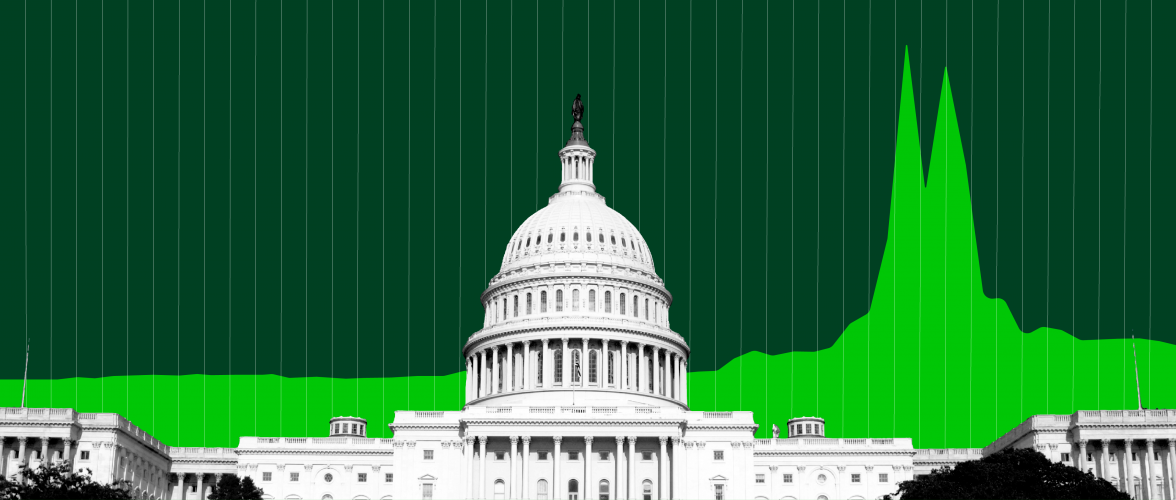
Posted on
February 19, 2021
4 Min. Read
Author
Kayla Johnson
What Financial Trading Apps Can Learn From Responsible Gaming Companies
App-based financial investing platforms have had breakout success during the pandemic, with millions of new Americans taking an increased interest in investing. The disruption brought by these financial startups was built on the premise of democratizing access to investing: removing barriers so that all investors – not just large institutions and wealthy individuals – have the opportunity to grow their wealth.
But like any disruptive technology, these startups bring potential for a perilous future as well.
Critics of this new wave of investing apps believe the companies operate irresponsibly without common safeguards from the financial services industry and are exposing amateur investors to a level of risk they don’t understand and for which they aren’t prepared.
Further, critics point out that some new investing apps use the same “growth hacking” techniques many social media companies have used to keep their users spending time in their app, making this new generation of investing apps “addictive by design.” These include:
- Subtle design tweaks such as labeling cash “buying power” encourage the full investment of money in user accounts rather than encouraging an asset allocation investing strategy.
- Gamification tactics like “most popular stocks” and “biggest daily movers” cause users to feel they are missing out and create psychological pressure to try to find the next big winner through potentially risky investments.
- “Instant deposits” allow investors to transfer money from their bank account and invest it immediately creating a dopamine rush. But users are required to wait multiple days after selling an investment before they have the option to initiate a transfer of money back to their bank, increasing the likelihood that money will be reinvested with new trades.
For at least a subset of new investors, day trading and short-term investing filled an entertainment gap when the sports world suddenly ended last March. In a stock market “that only goes up,” the risk of gambling-like behavior has been masked by the perceived safety of investing, causing even more new investors to jump in. But when the bubble inevitably pops, many people could lose it all. And the media, government and society will be looking for someone to hold accountable.
While stating “all investments involve risks, including the possible loss of capital” may avoid legal liability, these investing start-ups risk losing their permission to operate and innovate and could cease to exist unless they take real action to protect their users. As we will likely see in the aftermath of the Wall Street Bets saga, disruption in a highly regulated industry like the financial industry has the potential to be met with a level of regulation that start-ups and the tech world are not accustomed to.
Those practices could start with the design of the very applications that are intended to be mobile-first, accessible and intuitive – yet bear a strong resemblance to gambling activities in casinos and online gaming.
Lessons from The Gaming Industry’s Successful Model of Self-Regulation
While casinos and gaming companies are notorious for manufacturing and designing machines, games and experiences that enable casino players to spend more money and gamble longer, they also have robust responsible gaming programs in place to reduce gambling-related harm and help guests make informed decisions to keep gambling fun.
Rather than intentionally exploiting addiction, gaming trade groups and leading gaming companies have partnered with outside experts and academia to develop science-based approaches to encourage responsible gaming. For them, it’s the right thing to do as responsible companies, and this type of successful self-regulation has prevented further government regulation that could restrict their license to operate.
Here are four lessons from the gaming industry that investment startups and the financial services industry can leverage to provide greater protection for their reputations and customers.
(1) Invest in Responsible Gaming Initiatives and Programs
While many casinos and gaming companies are required to have responsible gaming programs in place as a condition of licensing, some have decided it is a critical part of being a responsible company and have gone above and beyond to integrate responsible gaming into everyday business practices.
Gaming companies have found a way to share healthy gaming practices in messaging to customers so they can understand the games better, but also better understand the basic concepts of gambling. This includes:
- Encouraging customers to take frequent breaks while gambling. Set a time limit.
- Control your wagers, don’t let them control you.
- Don’t gamble money that you can’t afford to lose, and don’t borrow money to gamble. Set a budget.
(2) Empower Employees to Protect Your Customers
In addition to providing educational resources for players, many gaming companies have gone a step further and hired dedicated gaming advisors for players who prefer additional guidance through verbal interactions and one-on-one support. The advisors receive extensive training for preventing gaming addiction and have the ability to provide referrals to free professional counseling services.
(3) Regular Reminders in-App, in Social, in Marketing
Responsible gaming companies take every possible opportunity to reinforce responsible gaming messaging, which are ultimately designed to create healthier gaming habits for their customers. Best practices include:
- Advertising materials (print, digital, etc.) are required to include a responsible gaming message, including a toll-free hotline number and website that the customer can access for assistance or resources for counseling.
- The materials are also required not to contain any claims that gambling will guarantee a customer’s social, financial or personal success or create a suggestion that gambling will lead to the probability of gains.
- Disclaimers containing hotline phone numbers are also listed in all social media postings, whether in the cover photo of social platforms or within the copy of the social post or an overlay on published creative assets.
(4) Self-Restriction Program
Through self-restriction and self-exclusion programs, customers can exclude themselves from casinos and online gaming apps, revoking all gaming privileges. Gaming operators in certain states are also required by law to remove customers from receiving direct marketing outreach and promotional materials. For customers who do not fully opt-out of gaming, they have the option to establish self-imposed limits on the amount of money they gamble with as well as time spent doing so. These limits and credit restrictions are in place to deter customers from betting more than they can afford to lose.
By being proactive and looking to the gaming industry’s successful self-regulation as a model, financial trading apps have an opportunity to protect their license to operate and build up the reputation equity that helps them responsibly serve the markets and investors.
Kayla Johnson is a campaign innovation manager at Purple Strategies where she helps client teams to better solve corporate reputation challenges using Purple’s proprietary digital solutions. Kayla spent five years working in the gaming industry for MGM Resorts International leading social media strategies. Prior to joining Purple, Kayla served as a state digital director for the Biden for President campaign.

Posted on
February 10, 2021
1 Min. Read
Author
Purple Strategies
Orphan Drugs, Pricing, And Reputation Risk
A “Life Science Leader” guest column by Purple MD Crystal Benton
Pharmaceutical companies got a reputation boost from their role in COVID-19 response. As these companies look to their next drug development and launch, a shift in approach could mitigate their reputation risk, Purple Managing Director Crystal Benton writes in a guest column for Life Science Leader.
“Reputation drag from ill-planned, high-cost launches could drain much, if not all, of the equity the industry has built through its efforts to rescue the world from the pandemic. And Washington has a notoriously short memory. … Mitigating that risk requires an enhanced approach that goes beyond brand marketing, for which many companies are not prepared. Pharmaceutical company leadership should consider three shifts in their approach to the drug development and launch process.”
Read the full article at LifeScienceLeader.com.

Posted on
January 28, 2021
5 Min. Read
Author
Nate Byer
Three Challenges Corporations Should Prepare for Now in the Post-COVID Economy
With the COVID-19 pandemic in the U.S. raging, it’s hard to find a moment to think about what our world will look like when the dust settles on this devastating health crisis. COVID-19 has and continues to pose an unprecedented challenge and regardless of partisan identity, Americans are seeing that challenge first and foremost as a health crisis.
It hasn’t always been that way. Our research focused on tracking beliefs about COVID-19 in early- and mid-2020 uncovered connections between Americans’ partisan identity and perceptions of what type of crisis we were facing. Simply put—early in the year, Republicans were more likely to see COVID-19 as an economic crisis, while Democrats more likely to see it as a health crisis.
As the fall and winter wore on, we saw a shift: Americans started believing COVID-19 was a health crisis more than an economic one, with a corresponding drop in those saying it was equally a health and economic crisis.
So what’s next? We all hope that as the depressingly high daily death tolls subside, and vaccination totals increase, we’ll be able to get back to normal. But while we may be able to visit our loved ones or step into a restaurant without fear, the reality is that the long-term economic impact of this crisis will have the spotlight to itself.
Corporate leaders need to start thinking now about how they want their companies to show up in that new reality, because the responsibility that corporate America has to their employees, their communities, and the nation will be a defining question of 2021.
There are three core economic topics that communications leaders should start working on now to help future-proof their businesses:
TOPIC 1
The growing disconnect between Wall Street and Main Street
Challenge
With Wall Street analysts predicting calm financial waters and continued stock market growth in 2021, we can expect continued frustration with the clear and present disconnect between how Wall Street thrives and Main Street struggles. The labor market clearly has a long way to go on the economic road to recovery, and we can expect a significant reform agenda on financial issues under a Biden administration, especially if Gary Gensler, a progressive former financial regulator and banker, is confirmed to lead the Securities and Exchange Commission.
Considerations
- Be mindful that investor communications do not exist in a vacuum. What you communicate to the financial community, especially during times of economic tension, will form the foundation of your corporate narrative for all stakeholders.
- Focus on investments that will allow you to succeed in the future. Investors, employees, customers and consumers need stability, so it will be well-received to talk about how you’re using your short-term success to build a strong foundation they can rely on.
- Elevate compelling voices from within, diversifying who carries your message both within and beyond the C-Suite.
TOPIC 2
Heightened employee concern about the future and the need to engage early and often
Challenge
The U.S. economy shed 140,000 jobs in December — the first month of decline since the earliest months of the pandemic. Our recovery has reversed as the pandemic has worsened and Congress has consistently failed to act.
The Biden administration will face significant economic challenges with the end of the pandemic still out of sight and political crisis consuming Washington yet again. Uncertainty about job security and burnout are real, and discord from inside (whether organic or organized) can be a killer for morale and your business’s ability to thrive.
Considerations
- Clearly and consistently communicate your values and how they inform your business decisions. Start building the muscle now so when employees voice concern or mobilize to apply pressure, you have built a strong foundation.
- Understand your liabilities related to controversial topics and government connections (such as donations to “Stop the Steal”–supporting members of Congress). The Project Lincoln divestment campaign is just the beginning of external pressure that will demand greater transparency and alignment with values as to how companies operate in the political arena.
- Commit now to regularly engaging your people on critical topics of a sociopolitical relevance. 2021 will be a year in which companies are expected to have a point of view on topics that go beyond the business of their business. Enlist your employees in helping you form, articulate, and defend your positions.
TOPIC 3
The high expectations for companies to have a positive impact in their communities, especially in the absence of trusted government institutions
Challenge
As a country, we no longer have faith in government’s ability to solve big (or sometimes even small) problems. And trust in once-revered institutions continues to nosedive following the 2020 election. As Axios reported, “business is the only institution that is now perceived as being both ethical and competent enough to solve the world’s problems. CEOs are the only societal leaders trusted to tell the truth and fix problems.”
Americans are struggling by almost every metric and the urgency of our challenges on everything from poverty and hunger to the environment is only increasing. Relatively small investments in community-focused corporate social responsibility (CSR) will not only make an impact on the ground, but also build credibility for companies in the short-term and down the line. That’s especially true when the problems companies tackle, and talk about tackling, are aligned with national priorities connected to but not impacting a company’s bottom line.
Considerations
- Relevant social impact work isn’t optional. Even if the mission is long-term, companies need to be in the game, living their purpose beyond the core of their business. Employees, investors, and policy makers expect it. Pick your topics, understand your potential impact, and start making investments.
- Don’t go it alone – engage your network (suppliers, customers, investors) to build a more impactful and resilient social impact program. Increase your chances of being seen as an agent of change by bringing others along with you.
- Resist the urge to talk about yourself and the size of your contribution. Talking about investments puts you in a sea of CSR sameness. Instead focus on the impact, showing not telling, and deprioritize your own logo and name in communications as much as possible.
CONCLUSION
We may see light at the end of the COVID-19 tunnel, but we have a long road to recovery ahead. Rebuilding an economy that meets the persistent needs of “Main Street” will take center stage soon enough, and companies need to be ready. That means having communications in place that reconcile the Wall Street/Main Street divide, programs established that embrace and support employee priorities, and investments made in precedent-setting programs dedicated to making relevant and lasting positive social impact. Doing these three things now can ensure that a company is ready for the pendulum swing from health crisis to economic crisis in 2021.
Purple is actively partnering with companies and industries to navigate the ever-changing COVID-19 pandemic and prepare for the future that will come after, bringing deep experience helping the world’s best-known companies navigate the world’s toughest challenges. Please reach out to author Nate Byer or any member of our Purple team to let us know how we can support you.
By Nate Byer | Managing Director | nate.byer@purplestrategies.com

Posted on
January 22, 2021
3 Min. Read
Author
Robert Fronk
Science Led Us To Vaccines, But It Will Take A Political-Style Campaign To Get Us To Vaccinations
There are suddenly glimmers of hope in our fight to contain and ultimately extinguish the COVID-19 pandemic. With two vaccines already approved for emergency use, others nearing the end of clinical trials, shots going into arms, and the number of Americans who say they are going to get the vaccine rising over the past 90 days, there are reasons for tempered optimism.
But like the virus itself, challenges continue to mutate, creating the need (and opportunity) for corporate leaders to adapt and commit to actions, which they are uniquely qualified to take, that put the collective good first, but also ultimately benefit their companies.
In order to move from vaccine development to herd-immunity vaccination coverage, expertise and activation in the areas of logistics coupled with personalized communication to drive product acceptance are required. And there is no group better equipped and suited to deliver these than American businesses.
As our focus shifts rapidly from vaccines to vaccinations, what insights can we extract from our most recent research and what does this mean for corporate leaders?
Among a range of options about what makes the Informed Public* more optimistic post-election versus September, “companies and government working together on the pandemic response” is the top answer among both Democrats and Republicans. While Operation Warp Speed certainly accelerated the development of vaccines and vaccine candidates, distribution might better be executed – and trusted – if handled by organizations used to getting the right products at the right time to the right places to thousands of locations and made available where “customers” want them. Shipping product is not the same as product availability.
But availability is just the start. Vaccination is a personal choice, similar to the choice people have of whether or not to vote, and if they decide to vote, who to vote for. And when it comes to COVID-19, we need to get people to vote with their arms!
So how do we get out the vote and get people to punch the vaccination ballot?
Successful political campaigns employ two critical approaches to persuade voters to choose their candidate:
- Identify the messengers, channels and messages most appropriate to each potential voter
- Focus most of the attention on the undecided or persuadable segment of the electorate
How does this campaign approach apply to vaccination? The days of asking Elvis to get inoculated against polio live on the Ed Sullivan Show, driving public acceptance of a vaccine, are over. So too are one-size-fits-all public service campaigns. What is needed is a modern communication effort, based upon the principles of successful political-style campaigns. We need to truly understand who has credibility and sway over unique segments of the public, where and how to reach them, with personally relevant, compelling messages that move them to action.
There has been much made of the vaccine-hesitant and the anti-vaxxers. But these labels won’t help us get to herd immunity. In our research, we have identified two critical, persuadable segments that will determine if we reach the vaccination levels that Dr. Fauci says are essential to creating herd immunity (75% to 80% of the population).
The first of these segments is the “Probably, But” segment, which comprises 35% of the Informed Public. This group, who ultimately expect to get vaccinated but plan to wait and see for many months, is twice the size of those who say they will not get the vaccine. We can get to 75% vaccination without the latter, but we need to motivate the former.
In political terms, the “Probably, Buts” are in essence waiting to see who wins the election before they are prepared to vote. A campaign specifically designed to upend this dynamic is essential – one uses the voices, messages and channels that are shown through research and testing to be best able to impact this segment.
Of equal importance is the segment representing 58% of the Informed Public, the “Cutting Corners Questioners,” who have questions about the safety and efficacy of vaccines brought to market so quickly. This segment wants to know that the “candidates” have the highest character, the election will be fair, and it is safe to vote. There are very specific voices and messages that are needed to alleviate the concerns of this sizeable and critical segment.
Just looking at these two segments, it is clear that no single national campaign to reach them will be effective.
At a national moment when companies are suspending political contributions, there is one candidate they can all support – vaccinations – and the campaign requires their resources and expertise to succeed.
PURPLE PULSE SURVEY OF THE US INFORMED PUBLIC. N=950. NOVEMBER 13-16, 2020.
PURPLE PULSE SURVEY OF THE US INFORMED PUBLIC. N=847. SEPTEMBER 30-OCTOBER 2, 2020.
PURPLE PULSE SURVEY OF THE US INFORMED PUBLIC. N=1,000. JULY 17-22, 2020.
* Surveys of the “informed public” – defined as adults who read the news at least a few times a week and closely follow at least one broad news topic
Purple is actively partnering with companies and industries to navigate the ever-changing COVID-19 pandemic and prepare for the future that will come after, bringing deep experience helping the world’s best-known companies navigate the world’s toughest challenges. Please reach out to author Robert Fronk or any member of our Purple team to let us know how we can support you.
By Robert Fronk | Managing Director | robert.fronk@purplestrategies.com
(A version of this article first appeared on LinkedIn)

Posted on
December 16, 2020
3 Min. Read
Author
Denise Brien
Are you asking the right question? Simple Yes/No About COVID Vaccine Intent Underestimates Public Support
Public intent to receive a COVID-19 vaccine is more nuanced than most polling captures, and the real answer is more optimistic for public health than is being widely reported.
Horserace political news coverage has always driven a large audience for media companies. So it’s no surprise that news organizations have keyed in on the next critical binary choice Americans face: Will people get the COVID vaccine?
The headlines and the polling on this question, however, can tell an incomplete and frequently misleading story about COVID vaccine hesitancy – inadvertently inflating the number of Americans who are not planning to get the vaccine.
According to most recent polls that are being widely reported in the media, roughly 4 in 10 Americans have indicated that they are not likely or not planning to get the vaccine when it is available. For example, here are recent poll numbers from four different national polls recently cited in the media:
- December poll: 40% not likely
- November poll: 39% would not get (probably + definitely)
- October/November poll: 42% no
- September/October poll: 37% not likely
If 40% are refusing to get vaccinated, there is certainly reason for concern. While not naming an exact figure, public health officials have indicated that “the vast majority” of us need to be vaccinated to get to herd immunity. So clearly, a lot is riding on increasing our collective level of coronavirus vaccine confidence and trying to persuade that still-too-large number who say “no” to the vaccine to join the “yes” camp.
Understanding public opinion requires asking the right questions.
Asking people how likely they are to get the vaccine, or asking them a simple binary yes or no question, over-simplifies what for many people is a much more nuanced decision – one that for many must account not just for whether, but also when to get the COVID vaccine. For this reason, we have been asking this question differently in our own public opinion polling. In our most recent poll, we find that some people plan to get the coronavirus vaccine immediately, as soon as it is available (38%); some people are more comfortable waiting a period of time before getting a vaccine (35% in our most recent poll, and of those, half say they just want to wait for others to get the vaccine first to ensure that there are no side effects and that it is as safe and effective as promised); and 9% say they are undecided or not sure. That leaves only 18% in the “no” camp, which incidentally, has moved relatively little since our initial poll.
Bottom line: Whether you are tracking public opinion about a public health challenge or about the reputation of a Fortune 100, the questions you ask and the way you ask them can drive vastly different results.
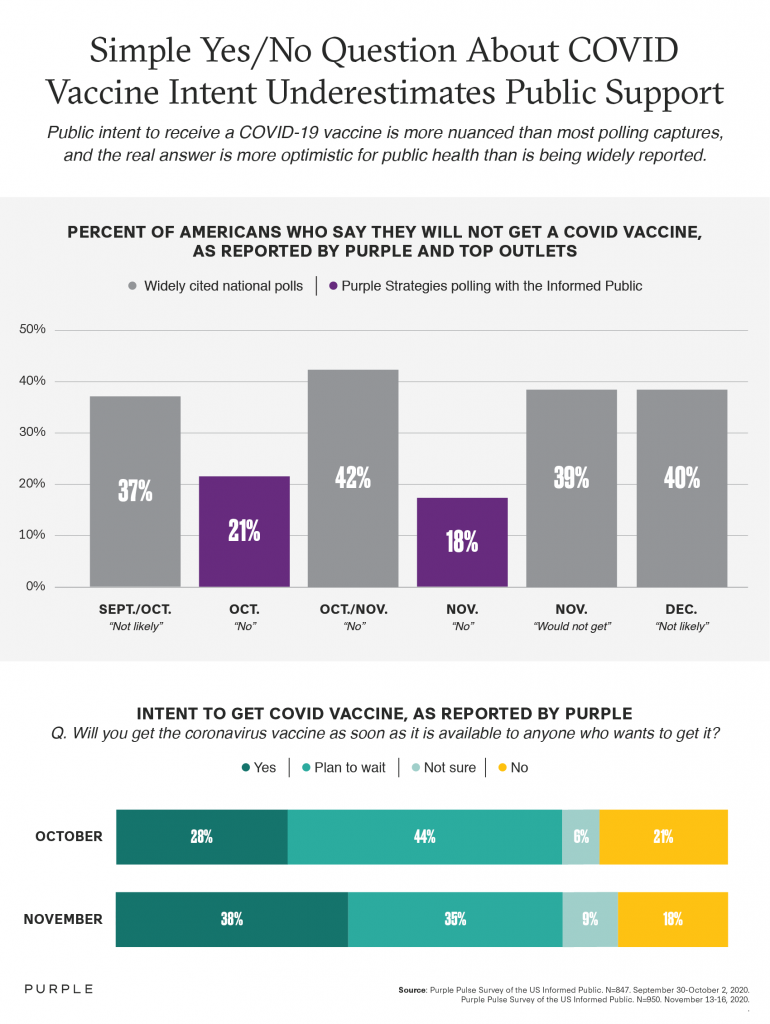
Purple is actively partnering with companies and industries to navigate the ever-changing COVID-19 pandemic and prepare for the future that will come after, bringing deep experience helping the world’s best-known companies navigate the world’s toughest challenges. Please reach out to author Denise Brien or any member of our Purple team to let us know how we can support you.
By Denise Brien | Managing Director | denise.brien@purplestrategies.com
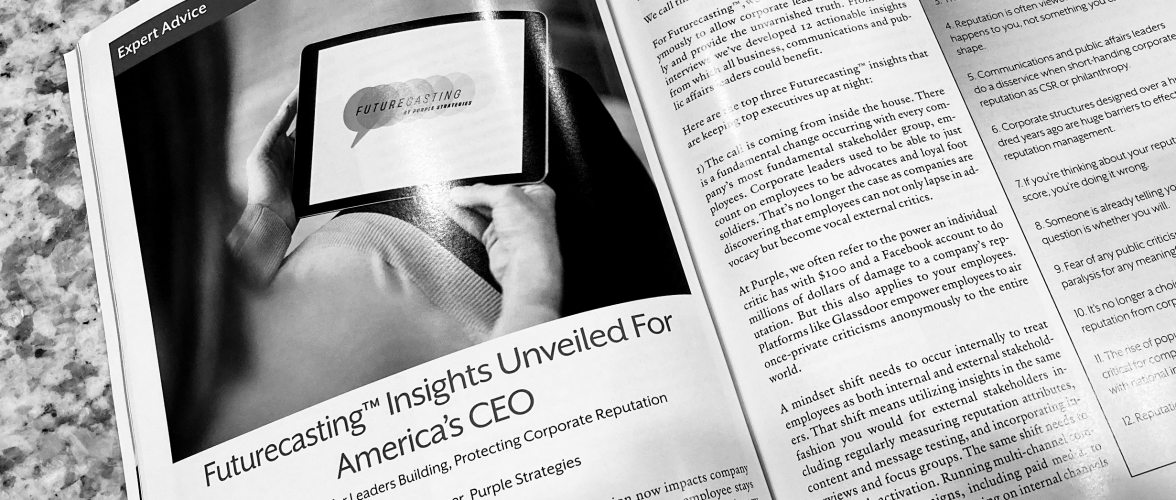
Posted on
December 9, 2020
1 Min. Read
Author
Purple Strategies
Futurecasting Insights Unveiled for America’s CEO
Purple partner Chris Durlak is a featured expert in the latest issue of The CEO Forum magazine, sharing insights for CEOs from Purple’s new Futurecasting platform. His article outlines what it takes for leaders to build and protect their corporate reputation, based on insights derived from in-depth interviews with 40 executives charged with the reputations of some of the world’s most important companies and brands.
“Change is constant,” Durlak writes. “Stakeholders including consumers, the public, policymakers and investors are demanding more from corporations than ever before. From Black Lives Matter to immigration to climate change, the public expects corporations to play a role in advancing more than just their business.”
Read the full article, or access the complete issue – “10 Transformative CEOs Strengthening our New World Through Leadership” – for more insights for today’s chief executives.
Explore more of the Futurecasting insights at futurecasting.com.

 Reclaiming Trust When Under Fire
Reclaiming Trust When Under Fire  Reclaiming Trust When Your Products – and Intentions &...
Reclaiming Trust When Your Products – and Intentions &...  Brad Dayspring Joins Purple Strategies as Executive Director
Brad Dayspring Joins Purple Strategies as Executive Director  Celebrating Growth and Leadership at Purple
Celebrating Growth and Leadership at Purple 